Binagoongan Baboy sa Gata is a delicious Filipino dish that combines tender pork belly with creamy coconut milk and savory shrimp paste. What makes this dish special is how the coconut milk creates a rich, smooth sauce that perfectly balances the strong flavors of the shrimp paste. The pork is cooked slowly until it's so tender it almost melts in your mouth, while gentle heat from chilies adds just the right amount of spice.
This dish is guaranteed to make any meal special. Serve it over hot rice, and watch as everyone at the table asks for seconds.
Jump to:
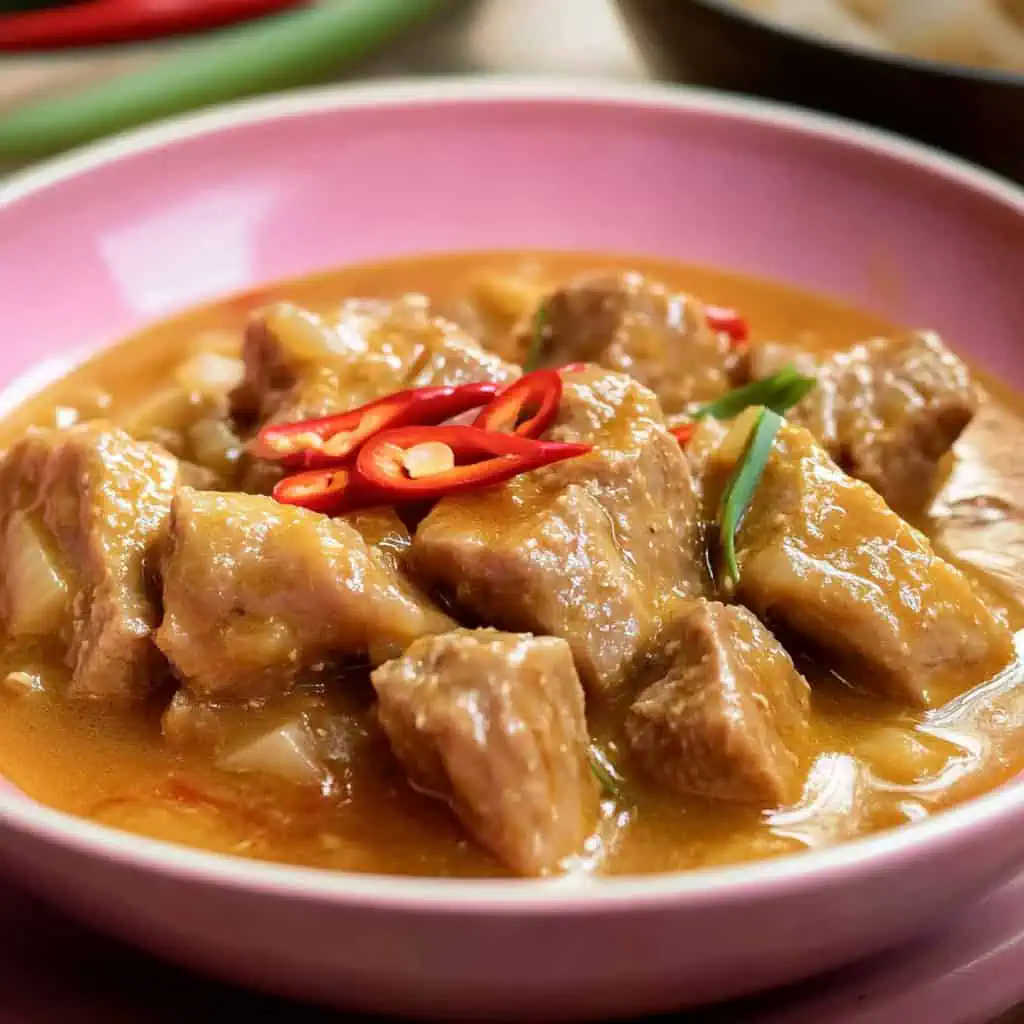
Why You'll Love This Recipe
- Perfect Balance of Flavors: The rich coconut milk (gata) perfectly tempers the strong umami of shrimp paste (bagoong)
- Fork-Tender Meat: Slow-cooking ensures melt-in-your-mouth pork belly
- Versatile Dish: Great for both everyday meals and special occasions
- Make-Ahead Friendly: Tastes even better the next day
- One-Pot Wonder: Minimal cleanup required
Ingredients
The ingredients in Binagoongan Baboy sa Gata create a perfect harmony of flavors and textures. Pork belly provides rich, tender meat with just the right amount of fat for a luxurious mouthfeel. Coconut milk adds creamy sweetness that balances the bold, salty depth of shrimp paste.
Garlic and onions form an aromatic foundation, while tomatoes contribute natural acidity and subtle sweetness. Thai chilies bring gentle heat that enhances rather than overwhelms. The splash of vinegar cuts through the richness, and a touch of sugar rounds out all flavors.
Combined, these ingredients create layers of umami, sweetness, acidity, and spice that make this dish irresistibly complex yet perfectly balanced.
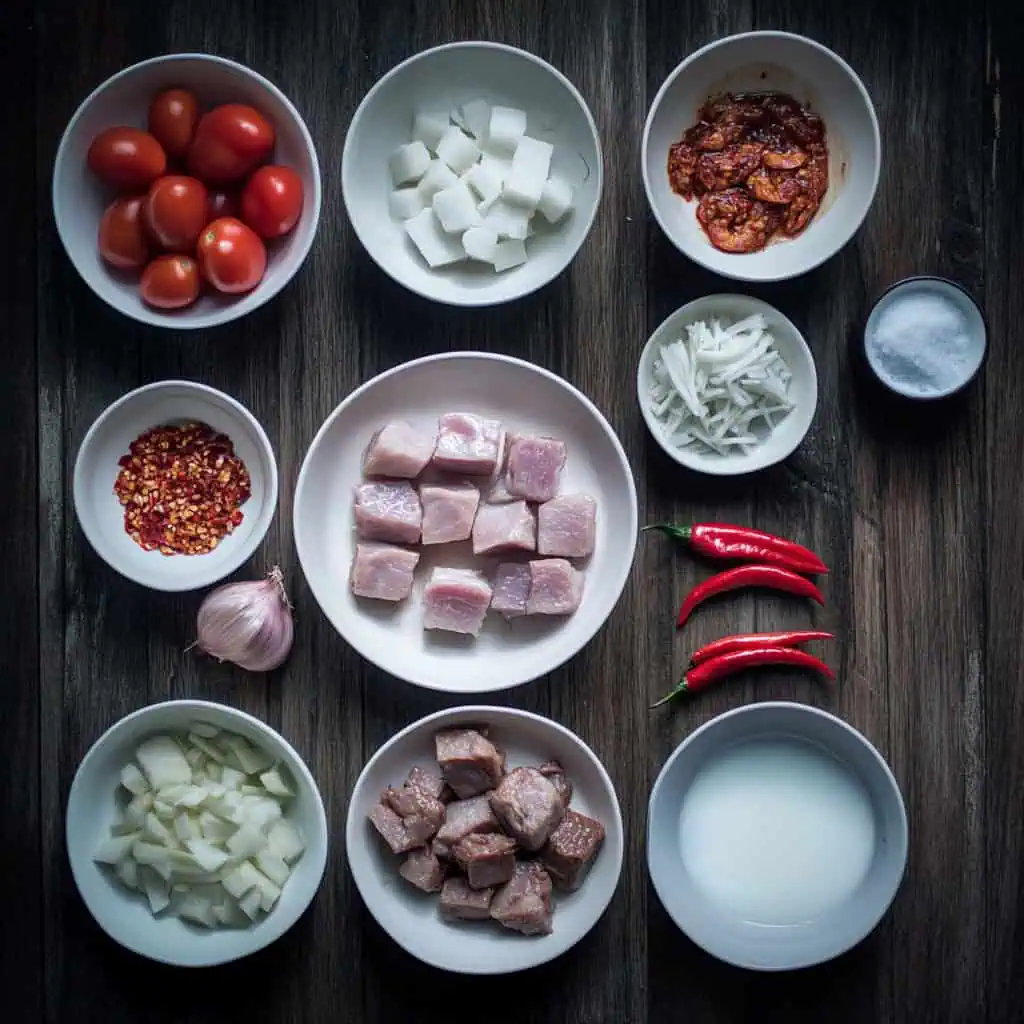
- 1 kilogram pork belly, cut into 1-inch cubes
- 400 ml coconut milk
- 2 tablespoons sautéed shrimp paste
- 1 large onion, finely chopped
- 6 cloves garlic, minced
- 2 medium tomatoes, diced
- 2-3 Thai chili peppers, minced
- 2 tablespoons vinegar
- 1 tablespoon cooking oil
- 1 teaspoon sugar
- Salt and pepper to taste
Equipment Needed
- Large Heavy-Bottom Pan or Kawali: Ensures even heat distribution and prevents burning of the delicate coconut milk sauce
- Sharp Chef's Knife: Essential for cutting pork belly into uniform pieces for even cooking
- Wooden Spoon or Sandok: Prevents scratching your pan and perfect for the gentle stirring needed with coconut milk
- Measuring Cups and Spoons: Ensures accurate ingredient proportions for balanced flavor
- Kitchen Scale: Provides precise meat measurement for consistent results
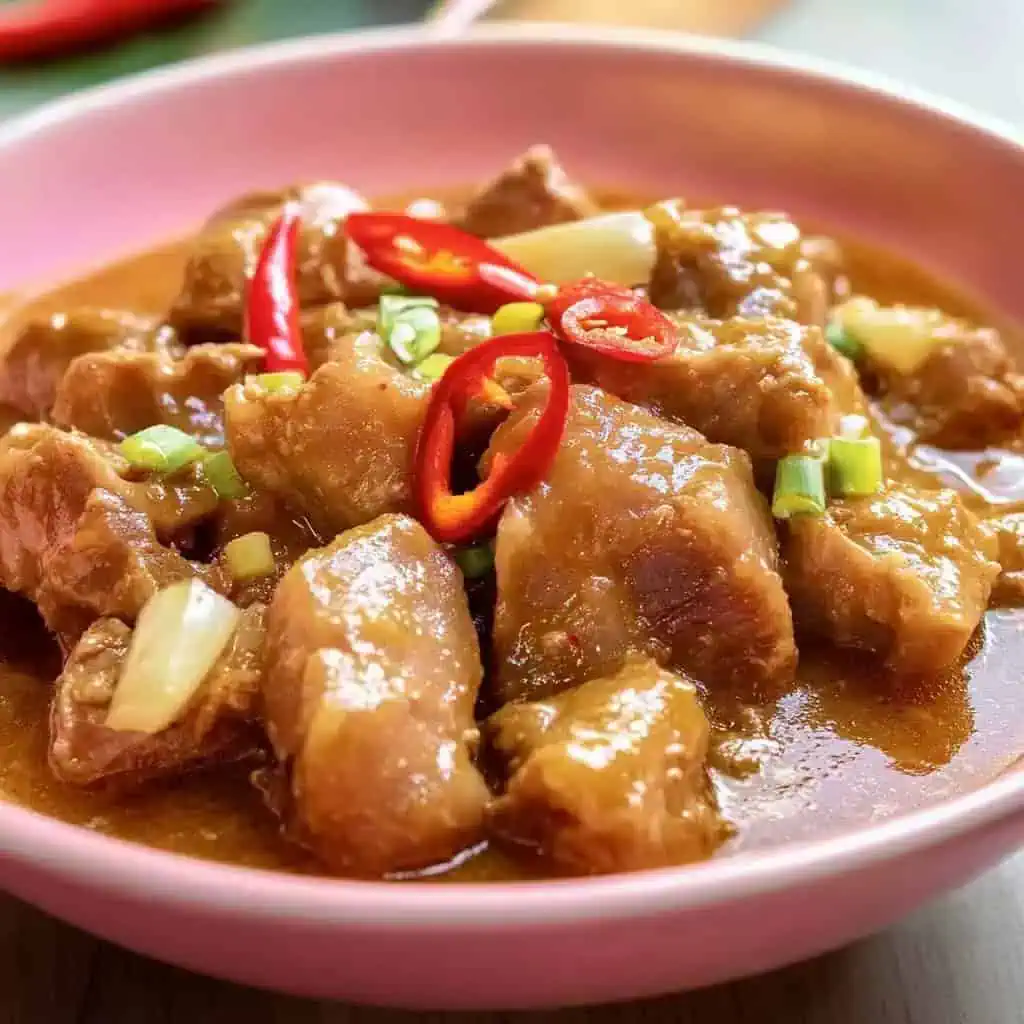
How To Make
- Preparation: Gather all your ingredients and equipment. Ensure your pork belly is cut into uniform 1-inch cubes.
- Sauté Aromatics: Heat your pan over medium heat and add oil. Once hot, add the minced garlic and cook until light golden, about 1 minute. Add the chopped onions and cook until they become translucent and soft, about 3-4 minutes.
- Cook Tomatoes: Add the diced tomatoes to the pan. Cook them until they start to break down and become soft, about 4-5 minutes. You can help them along by gently pressing them with your spoon.
- Brown the Pork: Add your pork belly pieces to the pan. Cook until lightly browned on all sides, about 8-10 minutes, stirring occasionally.
- Add Shrimp Paste: Add the shrimp paste to the browned pork and stir everything together. Let this cook for about 2 minutes to let the flavors combine.
- Incorporate Vinegar: Pour in the vinegar. Don't stir immediately - allow it to boil until most of the liquid has evaporated, about 3-5 minutes. This technique removes the sharp vinegar taste while maintaining its flavor.
- Add Coconut Milk: Pour in the coconut milk and add the chili peppers. Reduce the heat to low - aim for a gentle simmer, never a boil. Cover the pan and let it cook slowly for about 40 minutes, stirring occasionally.
- Check Tenderness: After 40 minutes, check if the pork is tender by poking it with a fork - it should yield easily. If not yet tender, continue cooking for another 10-15 minutes.
- Season: Once the pork is tender, add the sugar and season with salt and pepper to taste. Stir thoroughly and let it cook for another 2-3 minutes.
- Serve: Your Binagoongan Baboy sa Gata is ready when the sauce is creamy and the pork is fork-tender. Serve hot over freshly steamed rice.

Tips from Lola's Kitchen
- Easier Cutting: Freeze pork belly for 30 minutes before cutting for cleaner, more precise slices
- Prevent Curdling: Never let coconut milk boil rapidly - maintain a gentle simmer throughout cooking
- Perfect Consistency: If sauce becomes too thick, add water gradually (1 tablespoon at a time)
- Enhanced Flavor: Toast the shrimp paste separately in a small pan before adding for deeper, more complex flavor
- Traditional Addition: Add cubed eggplant in the last 5 minutes of cooking for authentic regional variation
- Layered Flavors: Allow ingredients to cook down at each step before adding the next component
- Quality Ingredients: Use fresh coconut milk when possible for superior flavor and texture
Substitutions
- Pork Belly: Substitute with pork shoulder or chicken thighs for a less fatty but still delicious version
- Coconut Milk: Use a combination of light coconut milk with a splash of coconut cream if full-fat coconut milk is unavailable
- Thai Chilies: Replace with bird's eye chilies, regular red chilies, or even a dash of red pepper flakes according to your heat preference
- Shrimp Paste: A mixture of fish sauce and anchovy paste can work in a pinch, though the flavor profile will be slightly different
- Fresh Tomatoes: Canned diced tomatoes work well, especially in off-season when fresh tomatoes lack flavor
Troubleshooting
- Sauce Too Thin: Simmer uncovered for 5-10 minutes, allowing excess liquid to evaporate until desired consistency is reached
- Meat Too Tough: Continue cooking on low heat, adding small amounts of water as needed to prevent drying out
- Too Salty: Balance with additional coconut milk, a splash of vinegar, or a pinch of sugar to counteract saltiness
- Too Spicy: Increase the amount of coconut milk or serve with cucumber slices to cool the palate
- Coconut Milk Separating: Lower the heat immediately and gently stir to recombine the sauce
Storage & Reheating
- Refrigeration: Store in an airtight container for 3-4 days in the refrigerator
- Freezing: Can be frozen for up to 3 months, though the sauce may separate slightly upon thawing
- Reheating on Stovetop: Warm over low heat with a splash of water, stirring gently to maintain sauce consistency
- Microwave Reheating: Heat on medium power for 2-3 minutes, stirring halfway through to ensure even warming
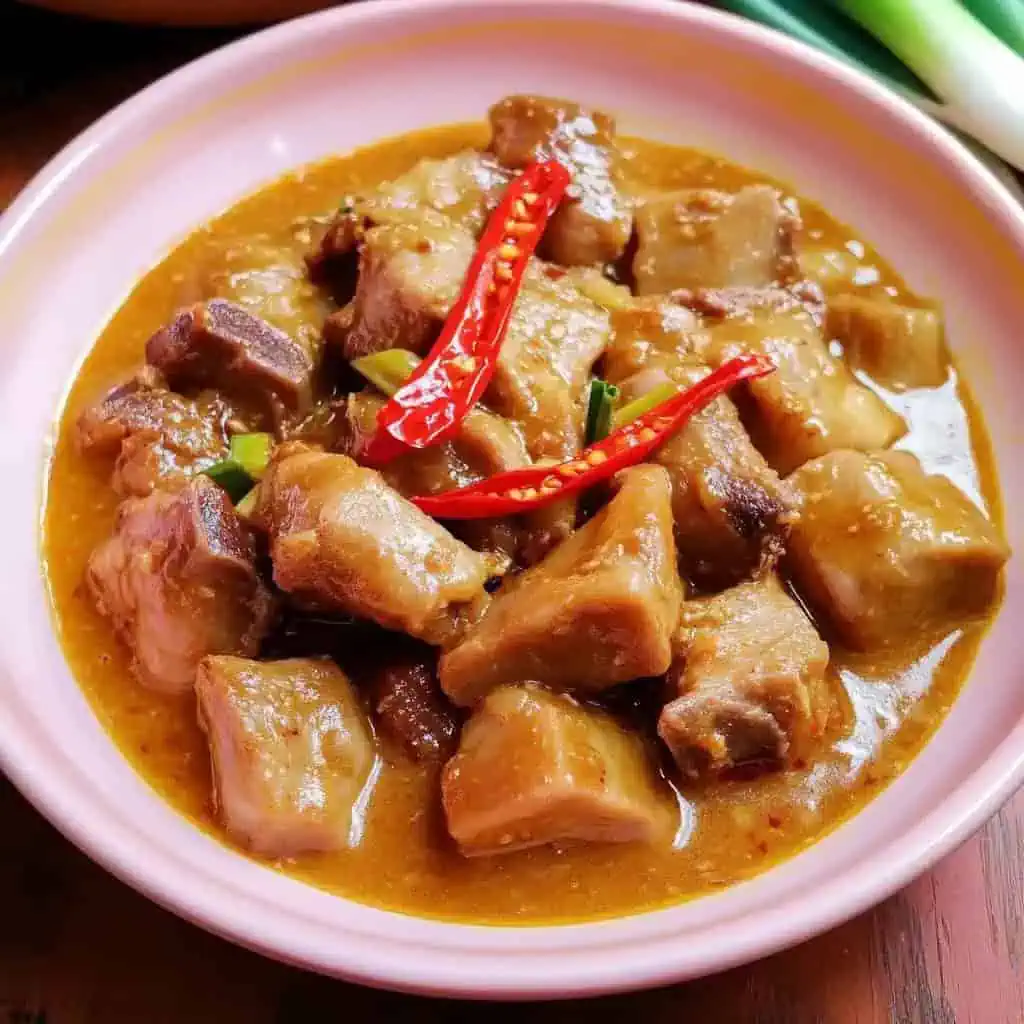
FAQ
Can I make this dish less spicy?
Yes, either remove seeds from chilies before adding or reduce the amount. For very mild flavor, omit chilies altogether and add a dash of paprika for color.
Why did my coconut milk curdle?
This happens when coconut milk is cooked at too high a temperature. Always maintain a gentle simmer and never allow it to boil rapidly.
Can I make this in advance for a party?
Absolutely! This dish often tastes better the next day as flavors meld overnight. Reheat gently before serving.
How do I know when the pork is perfectly done?
The meat should be fork-tender and easily pull apart, but still maintain its shape. If it's falling apart completely, it may be slightly overcooked but will still taste delicious.
Can I use canned coconut milk?
Yes, canned coconut milk works well. Choose full-fat varieties for the richest flavor and creamiest texture.
Is this dish gluten-free?
Yes, traditional Binagoongan Baboy sa Gata is naturally gluten-free, but always check your shrimp paste ingredients as some commercial varieties may contain additives.
Can I add vegetables to make it a complete meal?
Absolutely! Traditional additions include eggplant, but string beans, bell peppers, or spinach added in the final 5-10 minutes of cooking work beautifully, too.
What's the best rice to serve with this dish?
Jasmine rice or any medium to long-grain white rice complements this dish perfectly by absorbing the flavorful sauce.
Related
Looking for other recipes like this? Try these:

Binagoongan Baboy sa Gata (Pork Belly in Coconut Milk and Shrimp Paste)
Equipment
- Large Heavy-Bottom Pan or Kawali (Traditional Filipino Wok) Ensures even heat distribution and prevents burning
- Sharp Chef's Knife For uniform cutting of pork belly
- Wooden Spoon or Sandok (Filipino Kitchen Spoon) Won't scratch your pan and perfect for stirring
- Measuring cups and spoons (Panukat) Accurate ingredient portions
- Kitchen scale (timbangan) Precise meat measurement
Ingredients
- 1 kilogram pork belly liempo, cut into 1-inch cubes
- 400 ml coconut milk gata
- 2 tablespoons sautéed shrimp paste ginisang bagoong
- 1 large onion sibuyas, finely chopped
- 6 cloves garlic bawang, minced
- 2 medium tomatoes kamatis, diced
- 2-3 Thai chili peppers siling labuyo, minced
- 2 tablespoons vinegar suka
- 1 tablespoon cooking oil mantika
- 1 teaspoon sugar asukal
- Salt and pepper to taste asin at paminta
Instructions
- First, gather all your ingredients and equipment. You'll need a large heavy-bottom pan or wok, and make sure your pork belly is cut into 1-inch cubes.
- Heat your pan over medium heat and add oil. Once hot, add the minced garlic and cook until light golden, about 1 minute. Add the chopped onions and cook until they become clear and soft, about 3-4 minutes.
- Add the diced tomatoes to the pan. Cook them until they start to break down and become soft, about 4-5 minutes. You can help them along by pressing them gently with your spoon.
- Now add your pork belly pieces to the pan. Cook them until they're lightly browned on all sides, about 8-10 minutes, stirring occasionally.
- Add the shrimp paste to the browned pork and stir everything together. Let this cook for about 2 minutes to let the flavors combine.
- Pour in the vinegar. Don't stir it - just let it boil until most of the liquid has evaporated, about 3-5 minutes. This helps remove the sharp vinegar taste while keeping its flavor.
- Pour in the coconut milk and add the chili peppers. Reduce the heat to low - you want a gentle simmer, not a boil. Cover the pan and let it cook slowly for about 40 minutes, stirring occasionally.
- After 40 minutes, check if the pork is tender by poking it with a fork - it should be very soft. If it's not tender yet, cook for another 10-15 minutes.
- Once the pork is tender, add the sugar and season with salt and pepper to taste. Give everything a good stir and let it cook for another 2-3 minutes.
- Your Binagoongan Baboy sa Gata is ready when the sauce is creamy and the pork is fork-tender. Serve it hot over freshly steamed rice.
- Remember: Never let the coconut milk boil rapidly as this will make it separate. Keep it at a gentle simmer throughout the cooking process. If the sauce gets too thick while cooking, you can add a little water, one tablespoon at a time.
Tips from Lola's Kitchen
- Tip #1: Freeze pork belly for 30 minutes before cutting for easier slicing
- Tip #2: Never let coconut milk boil rapidly to prevent curdling
- Tip #3: If sauce is too thick, add water gradually (1 tablespoon at a time)
- Tip #4: Toast bagoong separately first for better flavor
- Tip #5: Add eggplant (talong) in the last 5 minutes for extra authenticity
Nutrition
The Story Behind Binagoongan Baboy sa Gata
Binagoongan Baboy sa Gata represents the ingenious fusion of two cornerstone ingredients in Filipino cuisine: bagoong (fermented shrimp paste) and gata (coconut milk). This dish emerged from the coastal regions of the Philippines, where both seafood and coconuts were abundant, creating a perfect marriage of land and sea flavors in one pot.
Traditional binagoongan, made simply with pork and shrimp paste, has been a Filipino household staple for generations. The addition of coconut milk, a technique believed to have originated in the Bicol region (famous for their coconut-based dishes), transformed this everyday dish into something more luxurious. The Bicolanos, known for their expertise in cooking with coconut milk, influenced how many Filipino dishes evolved to include this creamy ingredient.
The dish showcases the Filipino talent for adapting and enhancing recipes. What started as a humble way to preserve pork using bagoong became an elevated dish that demonstrates the sophisticated layering of flavors in Filipino cooking. The combination of pork belly (liempo), coconut milk (gata), and shrimp paste (bagoong) creates a trinity of flavors that's distinctly Filipino – rich, creamy, and deeply savory.
Home cooks across the Philippines have their own versions of this dish, passed down through generations. Some families add extra chilies for more heat, while others include eggplant (talong) as a traditional accompaniment. These variations reflect the diverse regional influences on Filipino cuisine, from the spicy preferences of Bicol to the sweet-savory balance preferred in other regions.
Today, Binagoongan Baboy sa Gata has found its way onto the menus of high-end Filipino restaurants, both in the Philippines and internationally, where chefs celebrate its perfect balance of flavors. It's a testament to how traditional Filipino home cooking can be elevated while maintaining its soulful, comforting essence. Whether served in a humble kitchen or a fine dining establishment, this dish continues to captivate food lovers with its unique combination of flavors and its representation of Filipino culinary heritage.
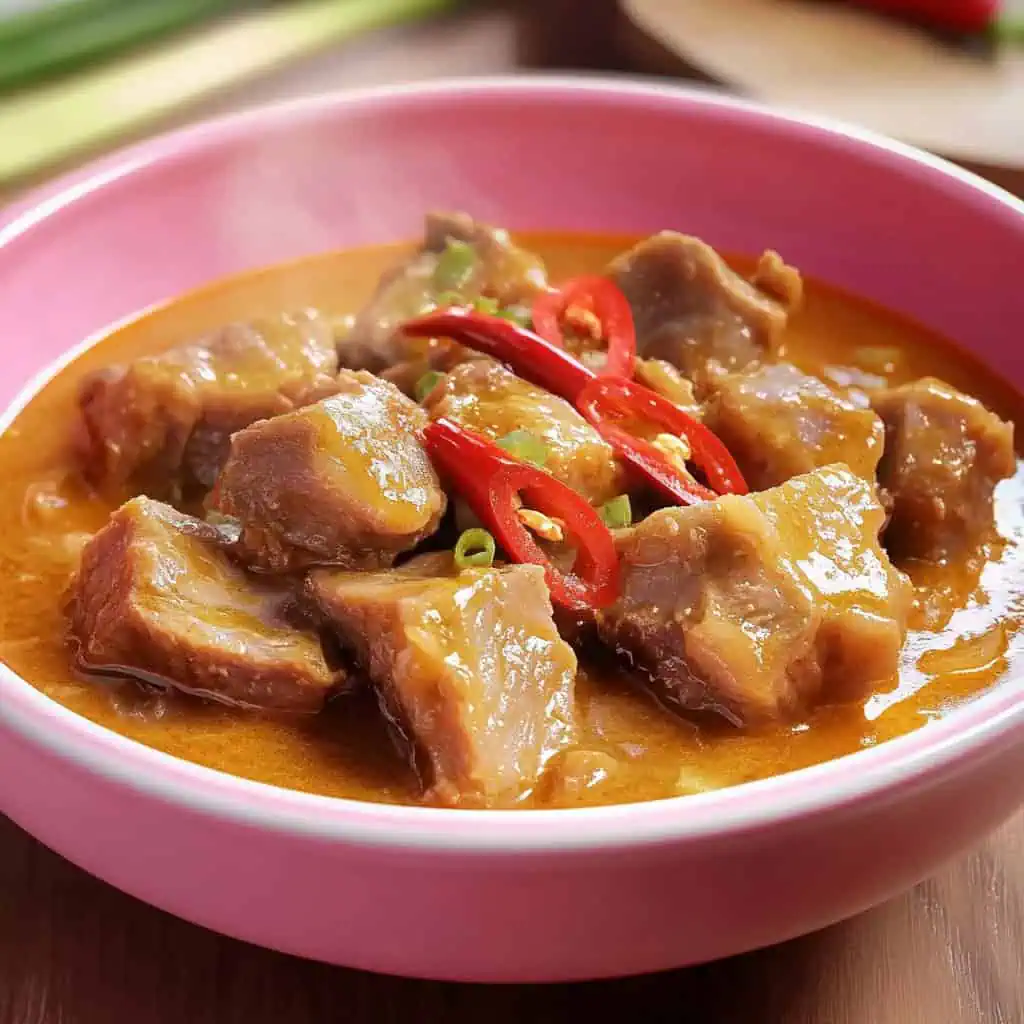






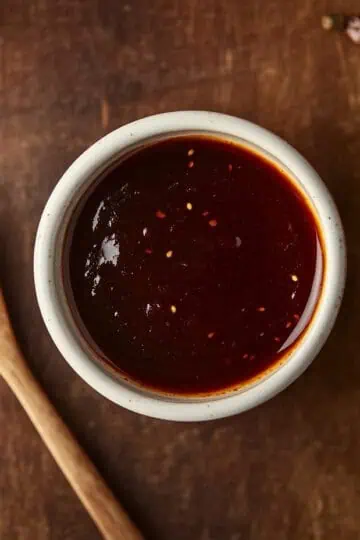


Comments
No Comments